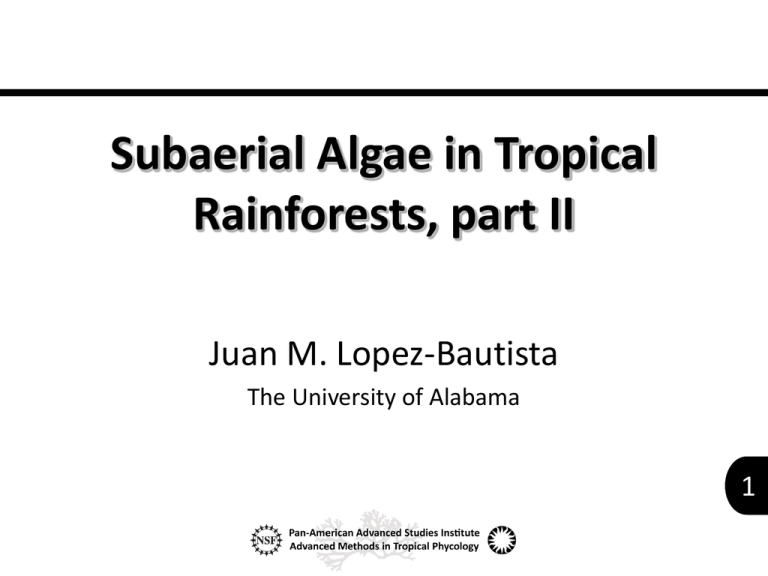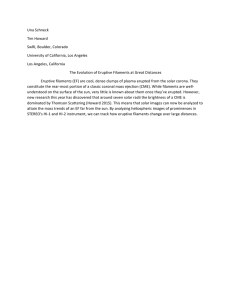13 Subaerial Algae Tropical Rainforests PartII
advertisement

Subaerial Algae in Tropical Rainforests, part II Juan M. Lopez-Bautista The University of Alabama 1 Overview Biodiversity and systematics of subaerial algae Collection and study of subaerial algae • Molecular systematics of subaerial microchlorophytes • Evolution of subaerial microchlorophytes 2 Molecular systematics of subaerial microchlorophytes 3 Klebsormidium Klebsormidium is one of the most common genera of terrestrial Charophyta It consists of few species of green algae occurring on soil, subaerial surfaces and semiaquatic habitats all around the world Pisa Italy 2005 The systematics of this genus has been entirely based on traditional morphology. The species-level relationships in Klebsormidium have not been examined with molecular tools Klebsormidium Galway Ireland 2004 Klebsormidium - One of the most widespread genera of terrestrial and freshwater green algae - Cosmopolitan distribution - Uniseriate filaments; no differentiated holdfast; one parietal chloroplast covering a half2/3 of the cell wall, with a single pyrenoid - 22 species currently described - Species-level systematics based almost entirely on morphology - Reproduction by biflagellate zoospores Principal morphological characters used for species identification in Klebsormidium 1) Width of filaments 2) Length of filaments 3) Cell shape 4) Presence/absence of constrictions between adjacent cells 5) Occasional presence/absence of biseriate parts 6) Presence of H-shaped pieces 7) Shape of the chloroplast Long Short Characters observable in culture 1) Growth habit: filamentous or fragmented 2) Presence/absence of a superficial hydrorepellent layer 3) Inducibility of zoospore release 4) Morphology of the zoosporangial aperture 5) Germination pattern of sporelings Fragmented Filamentous CITIES SAMPLED - Bergen (Norway) - Stockholm (Sweden) - Copenhagen (Denmark) - Galway (Ireland) - London, Plymouth and Manchester (England) - Hamburg, Rostock and Konstanz (Germany) - Bordeaux and Marseilles (France) - Porto (Portugal) - Pisa, Siena and Pavia (Italy) - La Valletta (Malta) - Koper (Slovenia) - Prague (Czech Republic) Morphology (field) Very uniform morphology; virtually no differences between strains from different cities • Filaments mostly long, sometimes mixed with short fragments • Filaments unbranched, 6-9 m wide • Slight constrictions between adjacent cells present in many strains • Cells regularly cylindrical • Chloroplast with smooth margin • Globular enlargements present in one strain (Pisa) • No biseriate parts or pseudo-branches Morphology (culture) • All strains growing well in both media used • Production of superficial hydrorepellent layer observed in the strains from Bergen, Galway, Hamburg and Konstanz • The strains from Marseilles, Pisa, La Valletta, Hamburg and Porto showed a marked tendency to fragmentation; after a few weeks the strains from Pisa and Marseilles consisted entirely of short fragments (2-5 cells) • Release of zoospores easily inducible only in the strain from Galway; release aperture indistinct • Sporelings in the Galway strain germinating with unipolar and bipolar pattern Although the morphology of the field material was virtually identical to Klebsormidium flaccidum, preliminary experiments in culture have shown a very large range of morphological variation • Most strains produce only 3D filaments that remain submerged • Others populations produce also a superficial layer of parallel filaments that cover completely the surface of the medium, • In other strains, the filaments get fragmented into many short fragments, giving the cultures the appearance of a green “soup” Submerged Submerged filaments Filaments + Superficial layer Short Fragmented filaments Samples originally corresponding to Klebsormidium flaccidum are spread along the rbcL tree Samples originally corresponding to Klebsormidium flaccidum are spread along the rbcL tree On the other hand, samples corresponding to different morphological species are grouped together Samples originally corresponding to Klebsormidium flaccidum are spread along the rbcL tree On the other hand, samples corresponding to different morphological species are grouped together Furthermore, specimens not possible to ascribe to any known taxa, and from distant locations, are found to be genetically similar! Conclusions • The populations of Klebsormidium occurring in European cities belong to at least 4 different evolutionary lineages • In the field material, these show an almost identical morphology and there are no morphological characters useful to distinguish them • More differentiation observed in culture, in which different strains show different growth habits • The taxonomy of Klebsormidium needs critical reconsideration; none of the morphological characters used for identification have phylogenetic relevance • The characterization of Klebsormidium flaccidum, type species of the genus, is a taxonomic mess that can be solved only sequencing the type specimen; depending on its identity, the whole genus may require a radical reassessment Lessons learned Overall, these experiments and analyses indicated that a great deal of genetic diversity is hidden behind a very similar morphology Morphology and cytology, even in “simple” and “common” forms, can be misleading Unialgal cultures and phylogenetic analyses are needed to re-evaluate these so called cosmopolitan species Spongiochrysis hawaiiensis Dense yellow-orange coating believed to be Trentepohlia by the local scientists Interesting unicellular green alga, reproducing with a budding-like mechanism known only in two subaerial species of the class Trebouxiophyceae: • Marvania geminata Hindák 1976 • Marvania aerophytica Neustupa & Sehjonová 2003/Stichococcus ampulliformis Handa et al. 2003 •However, sequences of the 18S rRNA, showed unequivocally that this alga is a member of the Cladophorales Siphonocladales lineage (Ulvophyceae) •Since this group was so far known to include basically marine species with complex thalli, this was a discovery of exceptional interest, that shed new light on the phylogeny of this algal group •Autosporulation has arisen separately at least 3 times (twice in Trebouxiophyceae and once in Ulvophyceae) Phylogenetic tree for a 18S rDNA sequence alignment of 1732 characters, with 55 representatives of the Viridiplantae and Spongiochrysis hawaiiensis. In a restricted analysis limited to 41 representatives of this group, our samples were included in the “Aegagropila-clade” with high support * 100/1.00 ML tree 18S rDNA (BS/Bayesian) Phylogenetic tree for an 18S rDNA sequence alignment of 1595 characters, with 41 representatives of the Siphonocladales Cladophorales complex, two outgroup taxa, and Spongiochrysis hawaiiensis * * * These data suggest that a marine ancestor gave origin to Spongiochrysis • Simplification of the thallus • Carotenoid production Similar trends during the colonization of terrestrial habitats have been found in the evolution of green algae Phylogenetic tree for an 18S rDNA sequence alignment of 1595 characters, with 41 representatives of the Siphonocladales Cladophorales complex, two outgroup taxa, and Spongiochrysis hawaiiensis * * Phylogenetic Considerations This alga represents a new subaerial lineage from the class Ulvophyceae It is the first known subaerial member of the Cladophorales Siphonocladales lineage For the unicellular habit and for the subaerial habitat this species is well differentiated from all other members of this lineage and can be considered the first known successful step of these algae into subaerial habitats New genus, new species: Spongiochrysis hawaiiensis Lessons learned The subaerial habit has developed in an algal group that was formerly believed to be entirely aquatic (the Cladophorales) A new subaerial lineage exists in the class Ulvophyceae It also showed that identical morphologies and identical mechanisms of reproduction have developed independently in separated green algal lineages Most importantly, great evolutionary surprises can be found in forest environments, if detailed surveys based on modern methodologies are carried out The Order Trentepohliales The group is unusual (to say the least!) in many respects Unusual features 1. Exclusively terrestrial and orange-red (unlike the majority of green algae, which are aquatic and green) 2. Differentiated sexual and asexual reproductive structures including an absolutely intriguing, unique zoosporangial abscission process 3. Remarkable bilaterally keeled flagella and flagellar apparatus (i.e. basal bodies and associated components), and 4. Evolutionarily puzzling phragmoplast-mediated cytokinesis found no where else in the entire chlorophyte lineage and analogous to but distinct from the phragmoplast-mediated cytokinesis of some green algae and the land plants in the charophycean lineage The order Trentepohliales Five genera currently recognized: Phycopeltis Printzina Trentepohlia Cephaleuros Discoid Epiphytic Prostrate Epiphytic or epilithic Erect Epiphytic or epilithic Discoid Obligated epiphyte Reduced Endophytic Isomorphic Isomorphic Isomorphic Heteromorphic Heteromorphic 28 species 8 species 38 species 15 species 4 species Trentepohlia Martius 1817 The genus Trentepohlia is the most diversified of the trentepohliacean algae, consisting of branched heterotrichous filaments, growing epilithic or epiphytic on the bark of trees, or in lichenic associations at exposed habitats forming conspicuous masses, usually yellow to orange in color As currently redefined, Trentepohlia shows a profused erect system, with a scarce or absent prostrate system; sporangia are ovoid, sporangiate-laterals solitary or grouped, borne terminally or on an enlarged terminal head-cell of a branched sporangiophore; gametangia are terminal only Described species: 35 Physolinum H. Printz 1921 The species type for the genus Physolinum was originally described as Trentepohlia monile, later the specific epithet was changed to T. moniliformis The genus Physolinum was based on the discovery of aplanospores as the sole reproductive structures found in this alga, and concluding that was markedly different from Trentepohlia Described species: 1 Printzina Thompson et Wujek 1992 Printzina is remarkably similar to Trentepohlia, except • • the presence of globular to reniform sporangia, and an almost pseudoparenchymatic thallus with few or any upright filaments Described species: 9 Phycopeltis Millardet 1870 The filaments of Phycopeltis grow openly or form a pseudoparenchymatous thallus, but always superficial upon the plant host or other surfaces Another feature distinguishing Phycopeltis from other superficial trentepohlialean genera is the terminal position of the papilla-pore or ostiole on the sporangium, which is opposite to the end of attachment whereas, in the other genera it is basal and adjacent to the area of attachment Described species: 25 Cephaleuros Kunze in Fries 1829 This genus is reported as an obligate epiphyte and subcuticular, that may be parasitic The prostrate portion can be open-filamentous to pseudoparenchymatous Sporangiophores bear one or more head cells subtending sporangiate-laterals Cephaleuros is one of the most studied genera among the Trentepohliales, in part for its worldwide distribution, its obvious presence and economic damage to their host Described species: 15 Stomatochroon Palm emend. Thompson and Wujek 1997 This alga grows as branching filaments endophytically in the substomatal chamber and protruding its sporangiophores through the stomata The reduced morphology of this alga is extraordinary, one species has become reduced to a single massive and lobed anchoring cell Described species: 4 Life cycles They have been described as either an isomorphic or heteromorphic alternation of generations Trentepohlia and Phycopeltis M n n n 2n 1n n F Isomorphic generations occur in taxa where the vegetative morphology is simpler (Trentepohlia & Phycopeltis), Cephaleuros and Stomatochroon n n M n 2n 1n n F Whereas a more complicated heteromorphic alternation is said to occur in taxa with a complex vegetative morphology (Cephaleuros & Stomatochroon) and possibly secondarily reduced morphology Reproductive Cells: sporangium is unique to this order Trentepohliales displays a characteristic abscission between the sporangium and the suffultory cell (or stalk cell) The sporangium and suffultory cell form together the sporangiate-lateral, which representa an important taxonomic character for the circumscription of the order Abscission The abscission involves a central area rich in plasmodesmata surrounded by a thickened area or internal ring In the periphery of this abscission septum there is a second area of thickened wall material, the external ring; the region between the rings lacks plasmodesmata Flagella The flagellate cells are compressed in a dorsiventral fashion with either two (gametes) or four (zoospores) flagella The overlapping configuration of the basal bodies in Trentepohliales is CCW and it has been cited as an evidence for an affinity with the Ulvophyceae Cytokinesis A phragmoplast-type cytokinesis has been reported for C. parasiticus and Trentepohlia odorata Chapman and Henk 1986 Ecology and Distribution •The geographic distribution of the Trentepohliales is basically pantropical •All Trentepohliales are subaerial, none having ever been found in aquatic habitats, freshwater or marine •The presence of sporopollenin-like substances in the cell walls, as well as a special pattern of carbohydrates and alcohols, probably are adaptative features against desiccation in the subaerial habitat •Trentepohliales are well known to form lichenic associations with fungi •Trentepohlia commonly occurs upon rocks or tree bark •Phycopeltis is an epiphyllous alga, growing on the surface of leaves •Cephaleuros is a strict epiphyte living beneath the cuticle of leaves, twigs, and fruits •Stomatochroon is found in the air chambers and stomata of leaves Questions on the evolution of the Trentepohliales Where does the Trentepohliales belong in the various proposed classification schemes of green algal classes? •Phragmoplast cytokinesis suggested an affinity with Charophyceae •The CCW flagella can be cited as evidence for an affinity with the Ulvophyceae •Based on biochemical and physiological features they have been classified as Pleurastrophyceae •Moreover, Trentepohliales share a rare ultrastructural feature (presumptive mating structure in the gametes) with members of a fourth class, the Chlorophyceae Molecular studies in green algae VIRIDIPLANTAE (CHLOROBIONTA, GREEN PLANTS) CHLOROPHYTA STREPTOPHYTA Chlorophycean lineage CHLOROPHYCEAE Charophycean lineage TREBOUXIOPHYCEAE LAND PLANTS CHAROPHYCEAE Chlorokybales Klebsormidiales Coleochaetales Zygnematales Charales ULVOPHYCEAE Mesostigma PRASINOPHYCEAE PRASINOPHYCEAE PRASINOPHYCEAE PRASINOPHYCEAE ANCESTRAL GREEN FLAGELLATE






